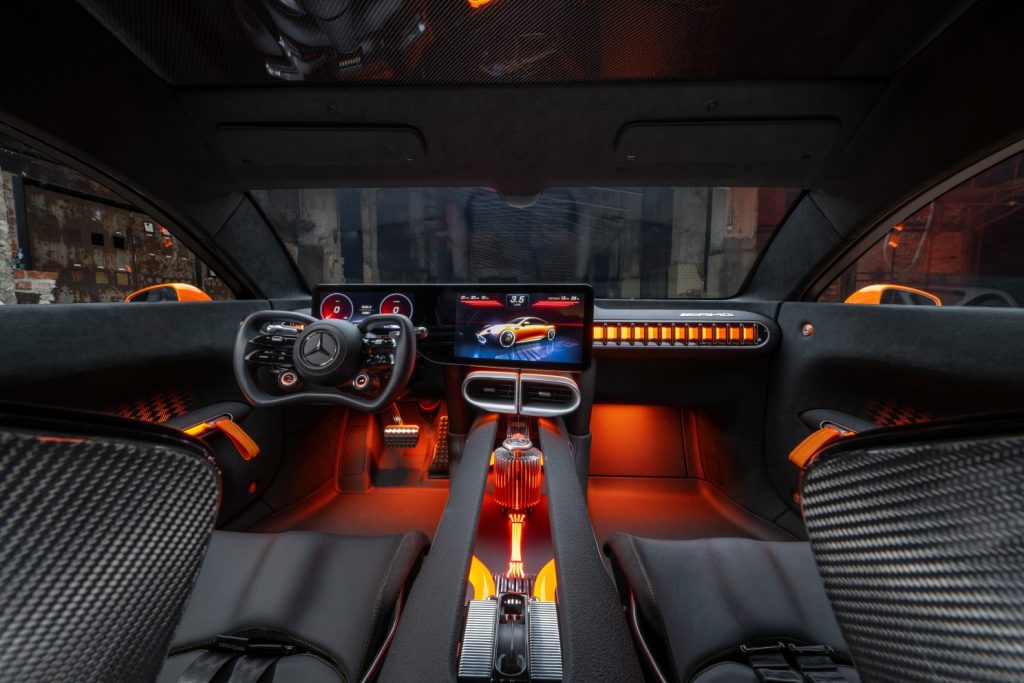Mercedes-AMG, the high-performance division of Mercedes-Benz, has introduced the CONCEPT AMG GT XX, a preview of what might be including in future production cars. The vehicle incorporates advanced 3D printed seat components that provide personalized customization and ergonomic support tailored to each driver’s physique, enhancing comfort and adaptability in a high-performance context.

Vehicle Overview and Exterior Design
The CONCEPT AMG GT XX is powered by three axial flux electric motors and a newly developed high-performance battery, created through collaboration between Mercedes-AMG in Germany and High Performance Powertrains in the UK, leveraging Formula 1 expertise to balance power and efficiency.
The exterior features a fastback profile with a low bonnet and sharply angled windscreen. Key design elements include a front grille with ten vertical struts, vertically stacked headlights, sculpted fenders, a double-bubble roof, and recessed door handles.
Aerodynamics are optimized with a specially designed underbody that balances downforce and drag through the Venturi effect, reducing lift without increasing drag. This enhances stability at speeds above 360 km/h and minimizes the need for a large rear spoiler.

3D Printed Seats and Interior Materials
The front seats combine carbon-fiber racing shells with 3D printed seat pads featuring an open lattice structure designed for enhanced ergonomic support. These pads are precisely customized using detailed body scans and can be quickly swapped to accommodate different drivers, drawing inspiration from motorsport endurance racing.
Upholstered in LABFIBER—a biotechnological leather alternative in Pearl Black—these seats reflect a commitment to sustainability. The sporty design is further reinforced by six-point safety harnesses.

Additive Manufacturing in High-Performance Automotive Design
Besides Mercedes-Benz, several other automotive brands are also investing in 3D printing technology. Last week, British automotive manufacturer McLaren Automotive partnered with California-based manufacturing technology firm Divergent Technologies to develop a series of 3D printed suspension components for the McLaren W1, the company’s latest high-performance hybrid supercar. This collaboration leverages additive manufacturing to produce structurally optimized parts—such as the front upper wishbone, aero-profiled lower wishbone, and front upright—engineered to meet stringent requirements for stiffness, durability, and aerodynamic performance.
In June, Conflux Technology, an Australian company specializing in heat transfer solutions and additive manufacturing, announced a collaboration with Italian hypercar manufacturer Pagani to tackle thermal management challenges within the transmission system of the Pagani Utopia. The Utopia features a 6-liter twin-turbo V12 engine developed by Mercedes-AMG, paired with a bespoke seven-speed transmission by Xtrac, available in both automated and manual configurations. This powertrain setup delivers the precise control and responsiveness demanded by extreme driving conditions.
Join our Additive Manufacturing Advantage (AMAA) event on July 10th, where AM leaders from Aerospace, Space, and Defense come together to share mission-critical insights. Online and free to attend. Secure your spot now.
Who won the 2024 3D Printing Industry Awards?
Subscribe to the 3D Printing Industry newsletter to keep up with the latest 3D printing news.
You can also follow us on LinkedIn, and subscribe to the 3D Printing Industry Youtube channel to access more exclusive content.
Featured image shows CONCEPT AMG GT XX. Image via Mercedes-Benz Middle East.
